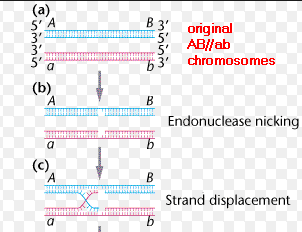The Holliday model postulated initiation of HR by a pair of single strand breaks (one in each duplex at identical sites), strand exchange to form symmetric heteroduplex DNA, and resolution of Holliday junctions to give either crossover or noncrossover outcomes. While this model explained some of the features of meiotic recombination in the fungi, it did not explain all of them nor did it explain some observations in other recombination systems. Foremost was the observation that recombination did not always result in a reciprocal exchange of a DNA segment to produce a symmetric pair of heteroduplexes. Instead, only one of the duplexes had a recombinant strand, resulting in the formation of an asymmetric heteroduplex. Another problem with the Holliday model was the need to introduce nicks in homologous duplexes at similar if not identical locations.
Studies on RecA activity and nucleofilament formation on singie-stranded DNA Ied Matthew Meselson and Charles Radding to develop a new model in 1975. The Meselson-Radding model (sometimes called the Aviemore model because it was first proposed at a meeting in Aviemore, Scotland) retains some key features of the Holliday model, namely the formation of heteroduplex DNA as a HR intermediate, mismatch repair of the heteroduplex DNA to give 3:1 and 1: 3 gene conversion events, and the Holliday junction intermediate that could be resolved as noncrossover or crossover. The main features of the Meselson-Radding model are as follows:
1. A single strand nick is introduced into a strand of one of the recombining duplexes.
2. DNA polymerase extends the newly created 3'-end, causing the displacement of the strand on the other side of the nick. With the assistance of RecA, the displaced strand with a 5'-p tail invades a homologous region in the second duplex to form a D-loop. This invasion by the 5'-P tail does not fit with the function of RecBCD in recombination.
3. The D-loop is cleaved, forming a single strand link between the two DNA duplexes. It should be noted that this intermediate has heteroduplex DNA on only one of the two DNA duplexes and so is asymmetric heteroduplex DNA.
4. The strands are isomerized or rotated around the crossed strand point to allow the free ends at the exchange site to be ligated, forming a Holliday junction.
5. The Holliday junction can branch migrate. Branch migration away from the initial site of strand invasion forms symmetric heteroduplex DNA. It was important to include the possibility to form symmetric heteroduplex DNA because, as discussed above, there are rare occurrences of postmeiotic segregation in two spores of a tetrad in yeast. In other fungal systems, such as Ascobobts immersus, the occurrence of postmeiotic segregation in two spores of a tetrad is more frequent. Flexibility of the model to allow for the formation of symmetric heteroduplex made it applicable to the recombination mechanism in awide range of organisms.
6. Last, the Holliday junction can be resolved to give noncrossover products or crossover products.








